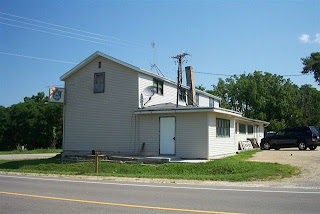
From Madison to Janesville with a stop in Union, 1864
Union Tavern, August 2009
The Janesville Gazette recently noted the celebration of Paul Milz’s 50 years of owning the Union Tavern in the tiny village of Union, Wisconsin (August 9, 2009, 2A) . Because I pass this tavern regularly on my commute to Hedberg Public Library, the article grabbed my attention.
According to Evansville historian Ruth Ann Montgomery, early Union settler “Samuel Lewis operated a hotel (sometimes called a tavern)” and an informal post office shortly after he and his family arrived in Union in September 1839. Very soon afterward, Union became the half-way point between Janesville and Madison on what is now Highway 14, and stagecoach drivers always stopped at the “Half-Way House” to change horses and drivers. By 1858, she says, the village of Union was large enough to sustain two dry good stores, one hotel or tavern, one physician, 1 district school with 45 pupils, a Baptist minister, 1 blacksmith shop, 1 tailor’s shop, a shoemaker’s shop, 1 cabinet shop, 3 joiners, 1 painter, 1 wagon maker and 2 masons. In fact, for many years, Union provided the only grocery store in the greater Evansville region (Evansville Review, February 27, 1975). Union seemed likely to outpace Evansville in population until the early 1860s when the railroad bypassed the village in favor of Evansville, and Union’s population started to decline.
Interestingly enough, in 1864 another Madison resident, Sarah Hobbins (Mrs. Joseph Hobbins, Jr.) made the same trip I regularly make from Madison to Janesville. Unlike my regular commute by car, this was a once-in-a-decade summer outing for her. Disdaining the railroad available at that time, she and her husband—“the Dr.”-- made the journey by horse and carriage, stopping in Union village to eat lunch at a “wayside inn”—possibly the Union Tavern itself! Her lunch is a contrast with my usual "dashboard dining" on a Veggie Delite sandwich from Subway. She described her journey in a letter to her mother:
"This is the first journey from home we have taken for pleasure alone during the ten years we have been in Madison, but the Dr. thought we both required a change, so on a fine June morning with little preparation except some sandwiches and some fine strawberries from our garden which Josephine gathered for us, we started in a south-westerly direction to Janesville about 40 miles from here. The most novel and attractive feature of the scenery through which we passed were the wide rolling prairies for miles and miles which reminded me of the ocean. The rich grass waving on them is very beautiful. Then there are vast tracts richly cultivated, where wheat and different varieties of grain were grown and looked most promising and luxuriant. We also passed many pretty residences. Again we seemed to be in regions quite wild, sometimes losing our way, for it is very difficult in a prairie region to select the right road, but the Dr. is very clever at this, seldom making a mistake.
“About one o'clock we dined at a place called UNION. It was one of the wayside Inns where people are glad to put up where they can find refreshments of some kind for want of a better. The nicely broiled salt pork, fresh eggs, pies, cakes, doughnuts, and cheese was quite a tempting repast. The Dr. made his dinner of an egg and potato [and] cup of tea, and luckily I thought of my strawberries which the landlady smothered in cream…”
“In the evening we reached Janesville where we had as excellent accommodations for the night as we should find at the Astor House in New York. Janesville is very pleasantly situated on the Rock River, being mostly built on rising ground, about the same size as Madison. The Asylum for the Blind is here with some of the finest educational buildings in Wisconsin and some very beautiful residences.” (Mrs. Hobbins’ letter is from Three Hundred Years American: The Epic of a Family, by Alice F. and Bettina Jackson (State Historical Society of Wisconsin, 1951, pp. 280-281.)
I love the description of the Hobbinses’ carriage ride through the prairie. Though it would be difficult in 2009 to lose one’s way on Highway 14, the rural character of its landscape—with corn and soybean crops replacing the wheat that once grew there--is still just as charming and peaceful as it was in 1864.
And I am longing to know: was it at the Union Tavern where the Hobbinses ate their lunch? Current Union Tavern owner Paul Milz stated that the original part of the tavern was built in 1846 and once served as a stagecoach stop, livery stable, and grocery store. He doesn’t mention its being a hotel or wayside inn. But as you can see in Montgomery’s description above, the lone tavern in the village in 1858 appears to have doubled as a hotel—a common occurrence on the frontier. Though Montgomery mentions that, at a later time, Union had a couple of hotels, one known—significantly enough--as the “Old Tavern” which was torn down in 1902, and another, known as the “Union Inn,” which was destroyed in a fire in 1934, both might have been built after the Hobbinses’s visit.
We’ll probably never know in which building the Hobbinses ate their salt pork, eggs, pies, and strawberries, but I like to think that it might have been Paul Milz’s Union Tavern that serves as a landmark on my own travels to Janesville.
--LG
